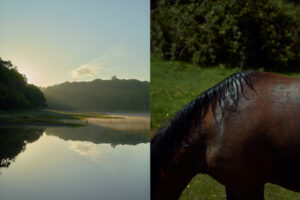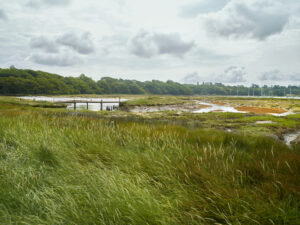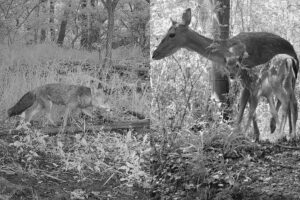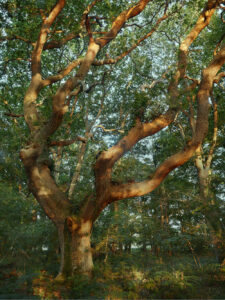Spectral visitants, nibbling mares and an abundance of butterflies: Mark Mattock observes his woodland neighbours by sun and by moon.

June: Allowing
“Bambi, quick! The thicket!” – Bambi’s Mother.
WTF? Over a thousand captures of a single swaying blade of grass that I didn’t notice right in front of the sensor of one of the camera traps I set a week ago.
But on the other.
Radiant glow-eyed apparitions, spectral visitants, emerge from the total dark beyond the cabin. Ghost fauna animated in crude stop-motion that stutters around the small LED screens as I scroll, excited like a kid again, through the previous week’s trappings. Reclusive, anti-social, suspicious neighbours revealing themselves unwittingly as I sit sipping the first coffee of the morning.
Badger, a complete surprise. Fox, every night without fail. Hedgehog, wood mice, woodcock, tawny owl. The creepy muntjacs, Puck (roe buck) and his doe; a small tight troupe of fallows. In one single frame a very bright UFO.
Crossing furze-land, on shopping day, billions of butter-yellow flowers have turned to rust almost overnight. The small-pebble-against-large-pebble sounding ‘chat’ of ‘furze chats’ (stonechats) and their fledglings coming from all over the rusting gorse maze. Each bush a fractal sculpture of magnetically gripped iron filings. Huge flocks of rasping, screaming, dusty starling chicks relentlessly chasing burned out adults, demanding to be fed. Avian adolescents. And opportune seasonal bounty for hawk, harrier and corvid. Feathered fodder. The hawthorns are also rapidly rusting. Along the hot sandy paths, six-legged, big-eyed, super fast, ferocious terminator bots scurry and leap-frog-fly short distances in front of me. Iridescent Green Tiger Beetles, each half an inch of exoskeleton-slicing superpredator.
Rising sun and the large fading face of a waning moon momentarily float at the same height just above the oak horizon, in the cyan zone, facing each other off across the marsh. One seems to be sucking the energy from the other. As I squat and squelch barefoot on soggy mats of gutweed, cutting samphire for later, a long column of noisy Canadians, like an armada of fairground ducks, quietly ride the current out of the marsh to the main river. Why some choose to slap-walk the whole way instead is a mystery. The cantankerous breeding season clearly over.
A panicked pair of Oystercatchers frantically circle the lazy-flap-and-glide marsh harrier, trying to deafen it, as it scours, with un-interruptible concentration, the verdurous samphire beds for their chicks. Foxes pad marks all over the bare mud, looking for the same. Old sea dog. Alerted by the slightly grating chatter of a sandwich tern, I look up at the very moment it stops to hover briefly then dive with laser-guided precision. Re-emerging with the tiniest fleck of glistening silver flicking at the yellow tip of its jet-black-dagger mandibles. How did something so delicate sound so heavy? Paper aeroplane became paperweight.
Yards from me a large fat green moth larva is being held down firmly in the furrow of an oak bough by the tiny, scrawniest scaly talon of a worn-out blue tit. Like a mini raptor. With its short stunted beak it tries to butcher the huge morsel but only succeeds in disemboweling it. Under relentless pressure it has to push the whole limp pillow of viscera into the begging gape of the impatient ball of feathers in front of it. The recipient gagging, unable to close its beak, momentarily still. Not long after a family of shrew-like treecreepers hit the oak boles like fridge magnets and plot spiralling (‘spiral’ is the collective noun for treecreepers) routes up, around, along the boughs, in magnetic jerks, disappearing into the canopy, traceable only by their high frequency peeps.
Still slumbering in the hammock on this warm indolent afternoon the hysterical yaffle, laugh, of a green woodpecker startles me awake. I missed the joke though.
Resume gawking up into the lush canopy. Movement directs my gaze towards it. A Great Spotted Woodpecker is cleaving away at the end of a precariously unstable rotted branch. Gripping with his tail, pulling apart the orb web stuck to it. Flakes, dust, dry glinting motes of oak and insect cuticle flutter down through alternating pockets of warm light and cool shade.
Turning to peer over the rim of the hammock, I scan the simmering marsh. I make out a haunched emaciated figure wobbling in the heat vapour over the purple spreads of marsh lavender. It looks like some grey, faded, dirty mac forgotten on a fence post. It’s a heron, who is alternating preening and panting in the hot briny air.

Beak open, throat fluttering, his tongue making it look like he’s got a broken chopstick stuck in it. He stretches, full on like a cat, neck fully extended, chin touching the ground, arse in the air yoga style. Resumes panting.
Grasshopper nymphs spray in all directions from in front of my scuzzy green and tannin stained feet as I traipse through the stiff estuarine grass to the foot bridge, to collect my recharged phone from the hot solar panel. Exactly like the fleeing shoals of mullet fry bursting through the water surface every time a big mullet innocuously torpedoes underneath them.
Dehydrated and sweating like a pig, I R&R in birch shade by the white-water-lily-covered pond, a magical oasis half way en route to the distant pub; across the ‘badlands’ of knee deep sphagnum and sundew bog, crunching tinder-dry heather and charcoaled gorse. In the hot halcyon haze wheezing greenfinches and house martins chatter. A ‘Mating wheel’ of a hawker dragonfly couple helicopter past in tandem like a flying machine built from salvaged parts in some post apocalyptic movie. The paler green female insect on the back, piloting the blue male, her huge eyes like helmet and goggles. Resting delicate damselfly couple shape a perfect heart between them. A sleek sweaty chestnut pony mare love bites and nibbles the neck of a white mare as she pisses loudly onto the parched turf. Horseflies just bite. Palpable vibrations from a single loud churr from a nightjar nearby. A hairy drunk bumblebee (bombus hypnorum) with tongue hanging out manoeuvres around a foxglove spike. The magenta bell-skirts, promiscuous petals, hems just lifted enough, invite cross species cunnilingus. High above a Hobby soars.
Walden (the wood mouse cabin burglar) is back. He’s turned up on the last three midnights, confidently treating the kitchen top and utensils like a personal gym as he runs, leaps, swings and climbs in search of some treat in the full spotlight of my phone torch. Despite the fact that I’ve been sleeping with the glass front wide open for the last week, he always noisily enters somewhere behind the unused gas-powered fridge.
I waited until late morning to go and check on something I was dying to catch up on. Last year’s record hot spell seems to have had a devastating effect on the honeysuckles. The shrivelled, desiccated sprays, having looked as if they had been sprinkled with glyphosate. Honeysuckle is the larval food plant of the white admiral butterfly, absolute oakwood icon. Perfect for them here. This morning was bright, sunny, heating up perfectly. Before I had even reached the first sunlit glade 100 meters up the track anticipation flipped to warming relief at the familiar site of the tropical-looking butterfly characteristically gliding and swerving in the distance. Conspicuous against the bright gravel track, the white-banded charcoal winged glider vanishes in the dappling scaly birch leaves, then passes in the the blue gaps above. I spent the next hot hour by the twenty metre long sun-pool with its bramble nectar bar. Tripping on White admirals, meadow browns, gatekeepers, ringlets, fresh peacocks, large skippers, new second brood holly blues; surrounded by the erratic whines, hums and drones of multifarious diptera (flies, bees, wasps) in multiple frequencies. Rustling crickets. A hissing hint of breeze in the birch tops.
A big shiny green lager can of a beetle — a rose chafer — manoeuvres drunkenly around the welcoming ‘lick me’ lollipop, sun-ray worshiping, blushing pink bloom of a common “I wanna be your dog” rose (Rosa canina). The antithesis of the neutered mutations, chastity petalled, ‘genetically modified’ sterile symbols of puritan hypocrisy and ‘well tended’ gardens. A rose is not a rose, is definitely not a rose.
Lifted by the sight of insect abundance I made my way back down to the cabin, restocking on mint and retrieving the camera trap that’s been out a couple of days opposite a hidden opening to the overgrown pheasant pen spinny.
Under the considerably cooler vibes of the cabin oaks I, once again, kid in suspense, scroll through the trappings. One sequence in particular: lots of robin fledglings, blackbird with worm, song thrush, woodcock, squirrel, squirrels, the pheasant-who-doesn’t-take-off; all interspersed with scenes where nothing seems to be going on. Suddenly, a head peering very cautiously from the thickets at the back; then it’s sitting on top of a long neck as it rises like a big-eared cobra; forelegs appear, a whole nervous fallow doe, closer, closer, she steps aside… BAMBI! Gangly-legged, spotty-sided, fawn-faced bambi.

The first photons that left the surface of the ascending orb of nuclear fusion eight and a half minutes ago, travelling at the speed of light, missing the distant oak tops, strike my retinas. Dawn. 5am. I put on my polaroids to protect my eyes from the 170,000 year old ‘tiny particles of light.’ (See glossary). Travelling 186,000 miles per second, ‘the fastest speed there is, therefore no time or distance,’ the electromagnetic radiation is actually just now.
That ‘now’ so silent I can almost hear the immense surrounding greens of June ‘eating the sun’ and politely belching damp oxygen. The snap, crackle and pop of photosynthesis. So still the only movement is the sound waves from a lone peewit’s syrinx travelling across the marsh to my eardrums at a mere 770 mph!
As the days progress towards the solstice I mostly stay in the vicinity of the cabin. Time indulged between hammock and fishing. Each day the sun drawing a massive 270o arch over me, in the eternal blue dome roof I cannot see beyond. I’m at the epicentre. Is this simple illusion the origin of our monumental anthropocentric self delusion?
A week of spectacular burning sky sunsets. The giant oak between the cabin and the main river becomes a lava lamp as I to-and-fro between lagoon and river during this prime fishing time. Pools of volcanic glow sliding slo-mo up and along its huge impressive boughs. In some moments spots looking so hot it’s more a massive iron welding project. More beams, some deflected by the river’s mirrored surface, penetrate the late evening gloom, illuminating numerous areas of the whole sylvan scene as if falling embers of adjacent forest fires are spreading and igniting. Patches of bracken become flames. The forest ablaze. My double shadow on the boles. Like global warming disaster footage. Eventually all is doused by dark.

I was a seventies Aurelian adolescent (see glossary) and have been a ‘butterfly head’ since I caught my first butterflies with a net made from my mum’s tights, (stockings would have been better) all that time ago. Butterflies have been a life long constant, and why a life long obsession with the way things look. Clearly a poor butterfly spring was becoming a classic butterfly summer. Signs suggesting the potential of something special brewing. End of June, time to leave, but I needed to time it right.
It’s very warm, very still, muggy. The light bright but heavily diffused. No shadow, just pure colour and texture. Perfect. I’m sweating profusely again — and smelling rank — by the time I come out of the woods, an hour from the cabin, and cross the road onto the vast heath. Blobs of Cross-leaved heather pop intensely old-school-bubble-gum pink out of the dark olive shrub-scape. Almost instantly ephemeral flakes of bright intense lead blue are swirling all over the scene, no more than knee high, creating the hypnotic illusion that there is a gentle breeze despite the utter stillness. ‘Swarm’ seems so wrong but, it is. Like a mayfly hatch. Diminutive butterflies with a ‘yee-haw’ sounding name float, flutter, fizz, flick all over the heather — Silver Studded Blues. Acid heath specialists. And that’s just the males, brown females double the numbers. Many involved in fluttering threesomes on the pink heather tops. Overwhelmed, I grasp what I’m looking at — sheer abundance. The kind of abundance that existed long before the term ‘baseline syndrome’ entered our vocabulary. The kind old Victorian Aurelians would have been familiar with. Some of whom collecting only the aberrations of downland species, chalk hill and adonis blues, such was that abundance. (I’ve never seen a good butterfly aberration in the wild). I’m staring through a wormhole to what once was, from a spot in one of the most nature-depleted countries in the world. It wasn’t the Aurelians.
The train comes to a standstill not so far from Clapham Junction. Out of the window a whole railway bank covered in bramble, in blossom, swarming with bees. Left alone nature happens. Life is indestructible.
Allow it.
*
Glossary:
170,000 years — the time it takes a photon to reach the sun’s surface from its core
Aurelian is an old term for lepidopterist: collector and breeder butterflies and moths. The noun is not related to Roman Emperor Aurelianus. It’s derived from ‘Aurelia,’ the chrysalis of an insect. From latin and greek meaning ‘the gold-coloured sheath of butterflies.’
*
Mark Mattock. Artist. Photographer. Publisher. Rabbit Fighter. @the_rabbit_fighters_club